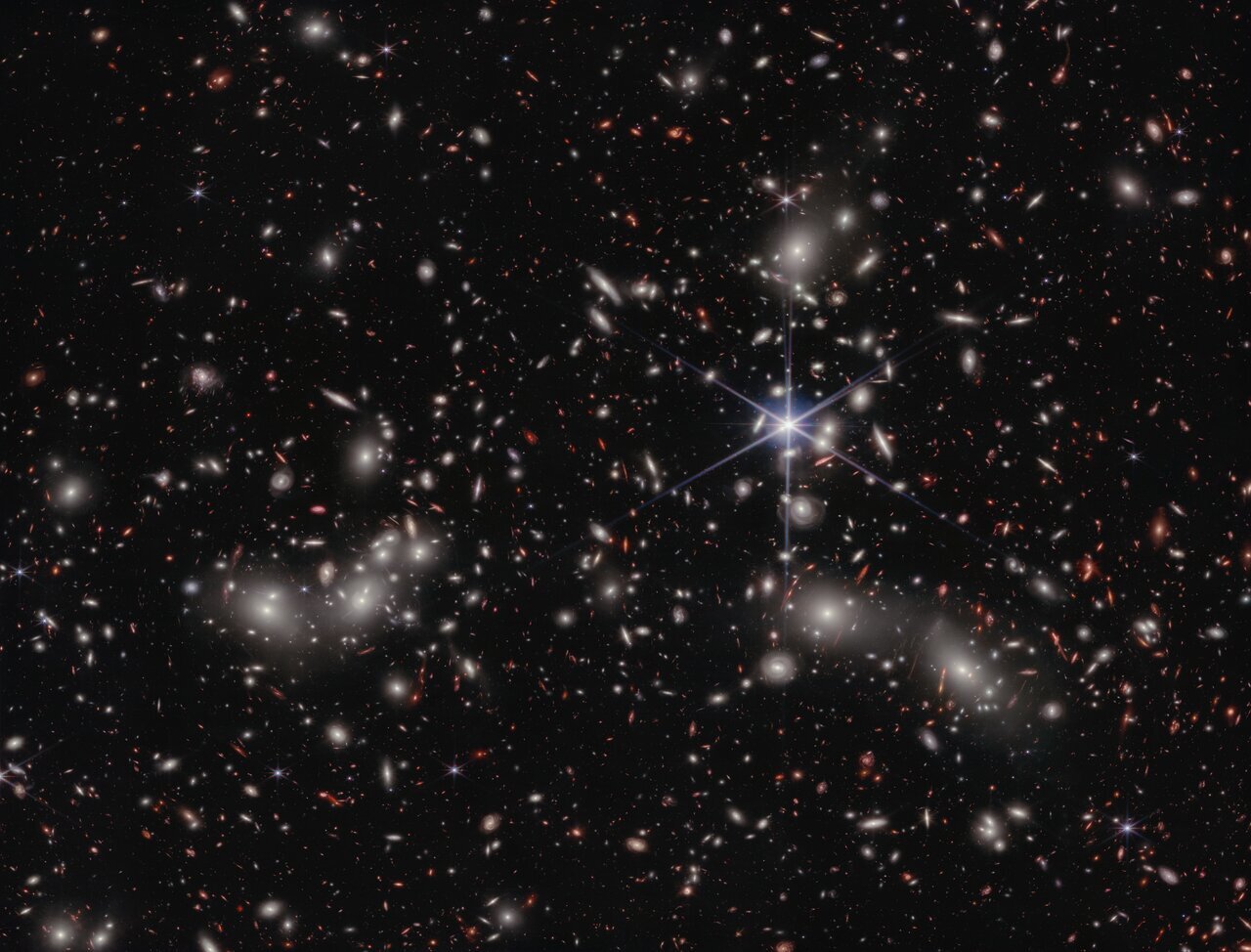The beloved telescope will soon begin working on a fascinating to-do list.
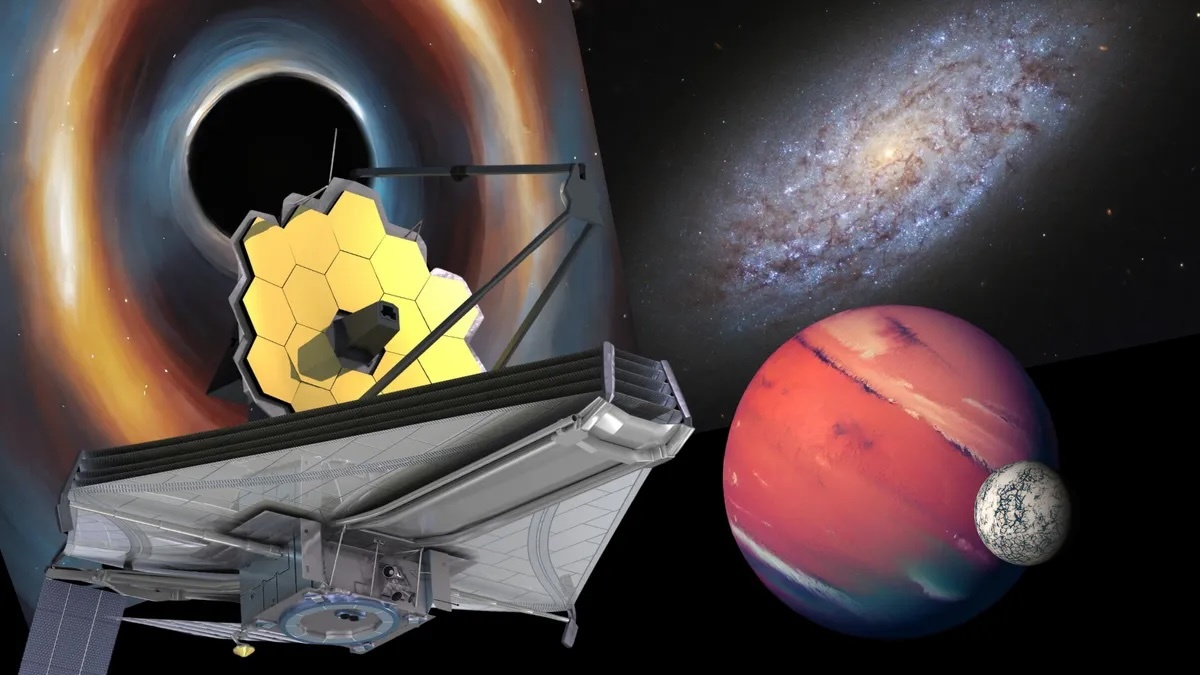
An illustration of the James Webb Space Telescope and some of its Cycle 3 observational targets including black holes, anceint galaxies and exomoons (Image credit: Robert Lea/NASA)
The Space Telescope Science Institute has announced which astronomy proposals have been selected to be given time with the James Webb Space Telescope over the next two years.
On Thursday (Feb. 29), the organization outlined 253 General Observers (GO) programs that will use humanity's most powerful and sensitive space telescope for a collective 5,500 hours between July 2024 and June 2025. This range is known as Cycle 3 of JWST operations.
Cycle 3 will build upon the previous two years of scientific advancements made by this $10 billion dollar telescope, which began beaming back data in 2022.
Some of the JWST's third-year targets include potential exomoons, or moons that surround exoplanets, exoplanets themselves in conjunction with their atmospheres, supermassive black holes and even distant galaxies that existed during the dawn of time. The JWST will also study large-scale structures in the cosmos to reveal details about the accelerating expansion of the universe and dark energy, the mysterious force that drives such movement.
The hunt is on for exomoons
One of the teams lucky enough to get time with the JWST during Cycle 3 will be searching for moons outside the solar system. These are known as extra-solar moons, or simply, "exomoons."
David Kipping, an assistant professor of astronomy at Columbia University, is part of the team that hopes to find moons around the exoplanet Kepler-167e in particular. This gas giant is around the size and mass of Jupiter and is located 1,115 light-years from Earth.
"We’re thrilled to get one of our proposals accepted!" Kipping told Space.com. "Our exomoon search around Kepler-167e was accepted, and it’s the best target we’ve ever had for moon hunting."
Thus far, exomoons have proved an elusive subject for astronomers because they are hunted using the same light-blocking technique employed to spot exoplanets around stars. However, this technique is difficult enough when looking for large worlds beyond Earth — searching for little exomoons with it is immensely challenging. Not only would exomoons block far less light than the exoplanets they orbit would, but they'd also need to be in the right position at the right time.
An exomoon that's detectable would have to be orbiting its planet precisely as that planets crosses, or "transits," the face of its parent star to obscure some light when viewed from our vantage point in the cosmos. That obstruction would be detected by scientists' equipment, which would allow them to reverse-calculate that an exoplanet (or potentially exomoon) gave rise to it.
Kipping is hoping that, by focusing on Kepler-167e with the JWST's Near Infrared Imager and Slitless Spectrograph (NIRISS), he and his team can make the first undisputed detection of an exomoon. "This is hopefully just the beginning of the exomoon revolution. New worlds that will surely hold some remarkable secrets," Kipping said.
Of course, the JWST's Cycle 3 GO projects also include a wealth of investigations focusing on exoplanets themselves and not just their potential moons. This includes a few that wish to determine whether some exoplanets have the conditions needed to support life as we know it.
Among those exoplanet habitability projects is one called "Constraining the atmosphere of the terrestrial exoplanet TOI-4481b." This will use the JWST's Mid-Infrared Instrument (MIRI) for 16 hours to determine if a roughly Jupiter-mass exoplanet, which orbits a star around half as massive as the sun that sits some 39 light-years away, has been able to hang on to its atmosphere.
The result could serve as a first step in understanding the habitability of rocky planets and establishing whether M-type stars, also known as red dwarfs, have terrestrial planets with significant atmospheres. This is important in the search for life beyond Earth because red dwarfs are the most common stars in the Milky Way.
Seeking out supermassive black holes
Astronomers widely believe the majority of our universe's large galaxies have supermassive black holes in their hearts with masses as great as millions, or even billions, of suns. Some of these supermassive black holes are actively swallowing gas and dust that surrounds them in disks of matter called accretion disks.
These monster black holes' gravitational influences are thought to heat the material in those accretion disks, causing them to emit bright radiation across the electromagnetic spectrum and create regions called Active Galactic Nuclei (AGN). Additionally, any matter that isn't swallowed by the black hole can be channeled to its poles, where it is blasted out as jets of particles traveling at speeds approaching light. When that happens, the phenomenon is a called a quasar.
The violent conditions of these events make AGNs and quasars the brightest objects in the universe, often luminous enough to outshine the combined light of every star in the galaxies around them. Our theoretical understanding of supermassive black holes has burgeoned since the Event Horizon Telescope(EHT) revealed the first image of a black hole, the supermassive black hole at the heart of the galaxy Messier 87 (M87), in 2019.
And the JWST's Cycle 3 missions will further contribute to this knowledge.
The JWST Cycle 3 supermassive black hole observation programs include the investigation of quasars in the early universe and the nature of the first black holes. Scientists hope to understand how those black holes may have influenced the growth of galaxies over billions of years.
The JWST's observations of supermassive black holes in the early universe could also reveal how these cosmic titans grew to the tremendous masses scientists observe — before the universe was even 1 billion years old. Such a question can be answered by using MIRI to investigate if a giant molecular cloud that existed around 13.2 billion years ago could have directly collapsed, birthing a "heavy black hole seed" that would account for a rapid growth mechanism.
Xavier Calmet is a researcher at the University of Sussex who investigates the intersection between black holes and quantum mechanics. He told Space.com he is particularly excited to see the JWST focusing on supermassive black holes and AGNS.
"The JWST Cycle 3 projects are very exciting," Calmet explained. "Given my own research interests, I am particularly eager to see what we will learn about black holes."
The James Webb Space Telescope goes big
One of the primary roles of the JWST is investigating objects in the early universe. The powerful space telescope has this capacity because the expansion of the universe stretches wavelengths of light from distant objects as this light travels toward us, moving the wavelengths toward the "red end" of the electromagnetic spectrum.
The longer that light has traveled to reach us, the more redshifted the light has become. This means light that has been traveling for around 12 billion years is extremely redshifted, all the way into the infrared region of the electromagnetic spectrum and outside the visible range we can see with the unaided eye. Effectively, infrared light is invisible to us. The JWST, however, is capable of observing this infrared light and thus helps to investigate the first stars and earliest galaxies, something it will continue to do in 2025 with several Cycle 3 GO projects.
Luz Angela Garcia is a cosmologist at the Universidad ECCI in Columbia who focuses on how dark energy expands the cosmos at an accelerating rate, which in turn helps with investigations regarding the universe's evolution. She is particularly enthusiastic about GO projects that will look at an era of cosmic evolution called the epoch of reionization, which occurred around 500 million years after the Big Bang.
During this period, neutral atoms of hydrogen populating the cosmos were ionized by radiation that stripped away their electrons and left them as ionized hydrogen, or hydrogen ions. Studying high-redshift galaxies can reveal more about this crucial stage in cosmic evolution, including how the first galaxies acted as the source of this ionizing radiation.
"Some of the proposals that catch my interest are 'Understanding galaxy formation at cosmic dawn,' 'Galactic Winds in the Early Universe' and 'Dead or alive? Unveiling the nature of massive galaxies in the early Universe,'" Garcia told Space.com. "All of these accepted projects seek to identify and characterize galaxies that are the drivers of the epoch of reionization.
"Most of these proposals focus on studying the properties of the first galaxies in the universe — very high-redshift systems that need spectroscopic confirmation."
This is just the tip of the celestial iceberg when it comes to the range of topics Cycle 3 GO projects will cover. Between 2024 and 2025, astronomers will also train telescopes on distant stars to better understand stellar physics and populations, as well as examine the gas that exists between stars that can become the building blocks of the next generation of stars and planets.
Though the JWST was designed with the study of distant objects in mind, Cycle 3 will also see the observatory used to study bodies within our own solar system. These will include hunting for the source of gas plumes coming from Saturn's moon Enceladus, investigating the dynamics of the Uranus' rings and characterizing icy objects that exist in the Kuiper Belt at the very edge of the solar system.
Looking beyond JWST Cycle 3, the call for Cycle 4 GO proposals will go out on August 1, 2024, with a deadline set for Oct. 16 this year. The Cycle 4 Telescope Allocation Committee (TAC) review will run between Feb. 3 and Feb.12, 2025, with selections revealed around March 5 next year. JWST Cycle 4 GO programs will then begin making observations of the cosmos on July 1, 2025.
A full list of accepted Cycle 3 JWST programs is available on the STScI website.
Quelle: SC
----
Update: 6.03.2024
.
JWST Captures the End of Planet Formation
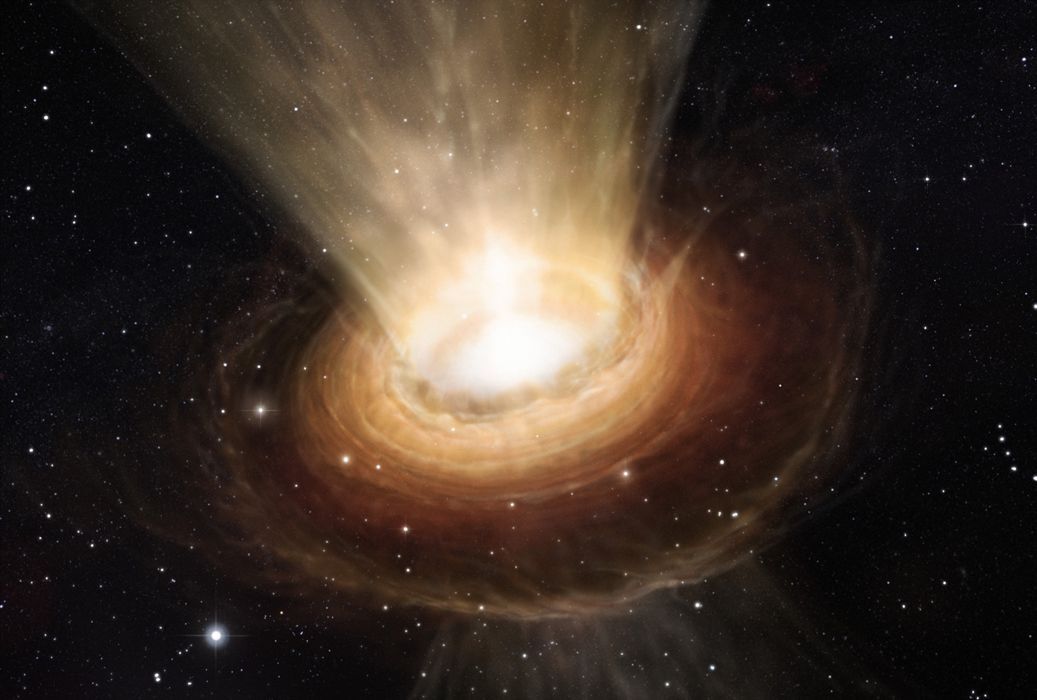
March 4, 2024, Mountain View, CA – The James Webb Space Telescope (JWST) is helping scientists uncover how planets form by advancing understanding of their birthplaces and the circumstellar disks surrounding young stars, in a paper published in the Astronomical Journal, a team of scientists led by Naman Bajaj of the University of Arizona and including Dr. Uma Gorti at the SETI Institute, image for the first time, winds from an old planet-forming disk (still very young relative to the Sun) which is actively dispersing its gas content. The disk has been imaged before, winds from old disks haven’t. Knowing when the gas disperses is important as it constrains the time left for nascent planets to consume the gas from their surroundings.
At the heart of this discovery is the observation of TCha, a young star (relative to the Sun) enveloped by an eroding disk notable for its vast dust gap, approximately 30 astronomical units in radius. For the first time, astronomers have imaged the dispersing gas (aka winds) using the four lines of the noble gases neon (Ne) and argon (Ar), one of which is the first detection in a planet-forming disk. The images of [Ne II] show that the wind is coming from an extended region of the disk. The team, who are all members of a JWST program led by Ilaria Pascucci (U Arizona), is also interested in knowing how this process takes place so they can better understand the history and impact on our solar system.
“These winds could be driven either by high-energy stellar photons (the star's light) or by the magnetic field that weaves the planet-forming disk,” said Naman.
Uma Gorti from the SETI Institute has been conducting research on disk dispersal for decades, and with her colleague predicted the strong Argon emission that JWST has now detected. She is “excited to finally be able to disentangle the physical conditions in the wind to understand how they launch.”
Planetary systems like our Solar System seem to contain more rocky objects than gas-rich ones. Around our Sun, these include the inner planets, the asteroid belt and the Kuiper belt. But scientists have known for a long time that planet-forming disks start with 100 times more mass in gas than in solids, which leads to a pressing question: when and how does most of the gas leave the disk/system?
During the very early stages of planetary system formation, planets coalesce in a spinning disk of gas and tiny dust around the young star. These particles clump together, building up into bigger and bigger chunks called planetesimals. Over time, these planetesimals collide and stick together, eventually forming planets. The type, size, and location of planets that form depend on the amount of material available and how long it remains in the disk. So, the outcome of planet formation depends on the disk's evolution and dispersal.
The same group, in another paper led by Dr. Andrew Sellek of Leiden Observatory, performed simulations of the dispersal driven by stellar photons to differentiate between the two. They compare these simulations to the actual observations and find dispersal by high-energy stellar photons can explain the observations and hence cannot be excluded as a possibility. Andrew described how "the simultaneous measurement of all four lines by JWST proved crucial to pinning down the properties of the wind and helped us to demonstrate that significant amounts of gas are being dispersed." To put it into context, the researchers calculate that the mass dispersing every year is equivalent to that of the moon! A companion paper, currently under review by the Astronomical Journal, will detail these results.
The [Ne II] line was first discovered towards several planet-forming disks in 2007 with the Spitzer Space Telescope and was soon identified as a tracer of winds by Project lead Prof. Pascucci at the University of Arizona; this transformed research efforts focused on understanding disk gas dispersal. The discovery of spatially resolved [Ne II] and the first detection of [Ar III] using the JWST could become the next step toward transforming our understanding of this process.
“We first used neon to study planet-forming discs more than a decade ago, testing our computational simulations against data from Spitzer, and new observations we obtained with the ESO VLT,” said Professor Richard Alexander from the University of Leicester School of Physics and Astronomy. We learned a lot, but those observations didn’t allow us to measure how much mass the discs were losing. The new JWST data are spectacular, and being able to resolve disc winds in images is something I never thought would be possible. With more observations like this still to come, JWST will enable us to understand young planetary systems as never before.”
In addition, the group has also discovered that the inner disk of T Cha is evolving on very short timescales of decades; they find that T Cha’s JWST spectrum differs from the earlier Spitzer spectrum. According to Chengyan Xie of the University of Arizona, the lead author of this in-progress work, this mismatch could be explained by a small, asymmetric inner disk that has lost part of its mass in only ~17 years. Along with the other studies, this also hints that the disk of T Cha is at the end of its evolution. Chengyan adds, "We might be able to witness the dispersal of all the dust mass in T Cha's inner disk within our lifetime!"
The implications of these findings offer new insights into the complex interactions that lead to the dispersal of the gas and dust critical for planet formation. By understanding the mechanisms behind disk dispersal, scientists can better predict the timelines and environments conducive to the birth of planets. The team's work demonstrates the power of JWST and sets a new path forward in exploring planet formation dynamics and the evolution of circumstellar disks.
The data used in this work were acquired with the JWST/MIRI instrument through the General Observers Cycle 1 program PID 2260 (PI: I. Pascucci). The research team includes Naman Bajaj (graduate student), Prof. Ilaria Pascucci, Dr. Uma Gorti, Prof. Richard Alexander, Dr. Andrew Sellek, Dr. Jane Morrison, Prof. Andras Gaspar, Prof. Cathie Clarke, Chengyan Xie (graduate student), Dr. Giulia Ballabio, and Dingshan Deng (graduate student).
For more information and to stay updated on this fascinating journey through space, follow the latest releases and discoveries as we explore the universe's wonders.
Quelle: SETI Institute
----
Update: 7.03.2024
.
The James Webb Space Telescope may have found some of the very 1st stars
We see the galaxy, designated GN-z11, as it existed just 430 million years after the Big Bang.

GN-z11 is found in the constellation of Ursa Major, in a region of sky being studied by the Great Observatories Origins Deep Survey (GOODS) project. (Image credit: NASA/ESA/CSA/STScI/Brant Robertson (UC Santa Cruz)/Ben Johnson (CfA)/Sandro Tacchella (Cambridge)/Marcia Rieke (University of Arizona)/Daniel Eisenstein (CfA).)
Evidence for the first generation of stars to exist in the universe has come to light, thanks to observations made by the James Webb Space Telescope (JWST). The proof is located in one of the most distant galaxies known.
The galaxy, designated GN-z11, was discovered by the Hubble Space Telescopein 2015 and, prior to the launch of the James Webb Space Telescope, it was considered the most faraway galaxy known. With a redshift of 10.6, it makes more sense to talk about how long ago it existed, rather than how far away it is. That's because we see GN-z11 as it was just 430 million years after the Big Bangdue to the time it took for its light to travel to our corner of the cosmos. For comparison, the universe today is 13.8 billion years old.
As such, GN-z11 was a prime target for the JWST to study. Now, two new papers describe profound discoveries about GN-z11 that reveal vital details about how galaxies that existed in the early universe were able to grow.
GN-z11 is the most luminous galaxy known at this particular redshift, and indeed this has become a common theme for high redshift galaxies now almost regularly being found in the early universe by the JWST. Many of them appear much brighter than what our models of galaxy formation predict they should be. Those predictions are based on the standard model of cosmology.
Now, the JWST's new observations seem to have shed light on what is going on.
An astronomy team, led by Roberto Maiolino of the University of Cambridge, has probed GN-z11 with the JWST's two near-infrared instruments, the Near-Infrared Camera (NIRCam) and the Near-Infrared Spectrometer (NIRSpec). The researchers discovered evidence for the first generation of stars, called Population III stars, as well as for a supermassive black hole gobbling up huge amounts of matter and growing at a vastly accelerated rate.
Scientists can calculate the age of a star based on its abundance of heavy elements, which would have been formed by previous generations of stars that lived and died, spewing those heavy elements into space where they ultimately get recycled in star-forming regions to form new stellar bodies. The youngest stars that have formed during the past five or six billion years are referred to as Population I stars, and have the highest abundance of heavy elements. Our sunis a Population I star. Older stars contain fewer heavy elements because there had been fewer generations of stars before them. We call these Population II stars, and they live in the oldest regions of our Milky Way galaxy.
Population III stars, however, have been purely hypothetical up until now.
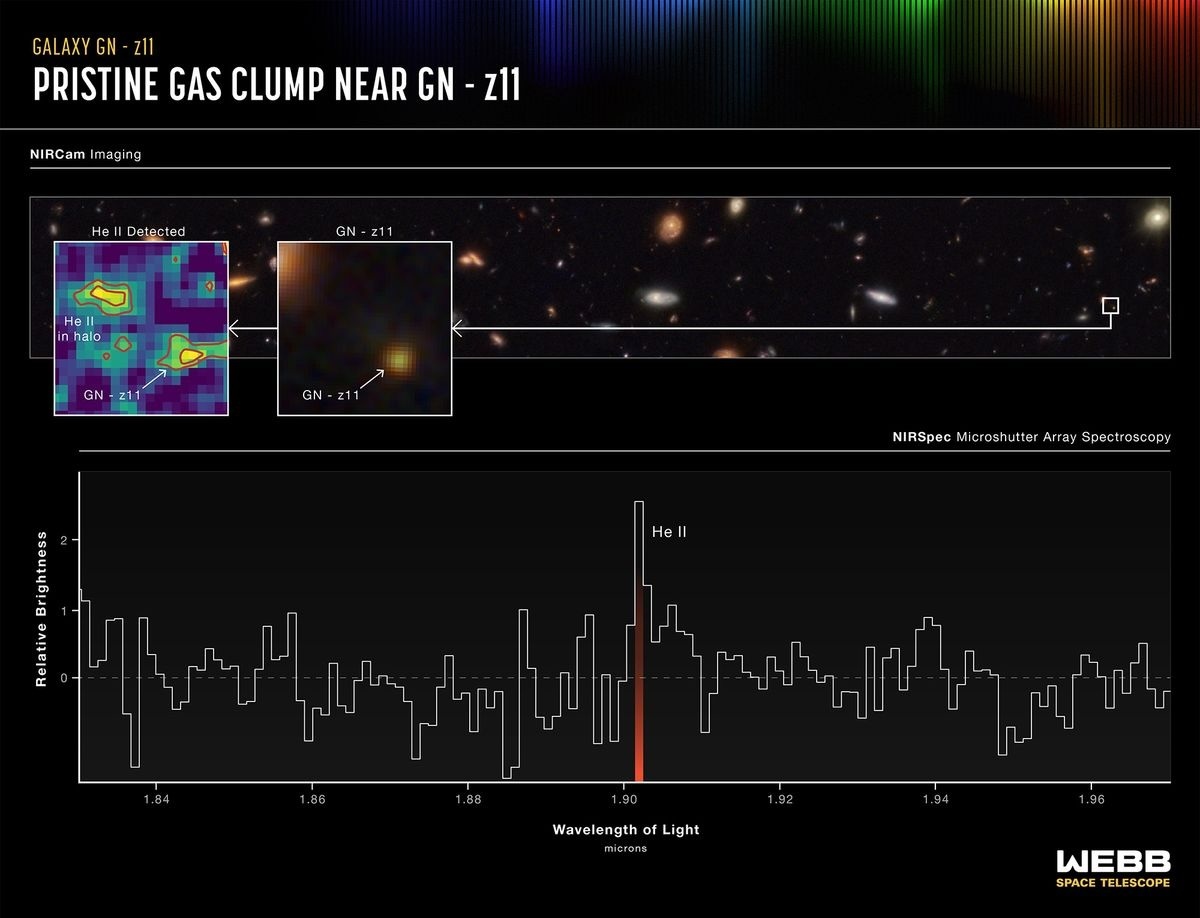
The spectrum of the clump of pristine helium gas that has provided evidence for the first stars. (Image credit: NASA/ESA/CSA/Ralf Crawford (STScI))
These would have been the first stars to form, and because no other stars came before them, they would have contained no heavy elements and be made from only the pristine hydrogen and helium forged during the Big Bang. These first stars are also thought to have been extremely luminous, with masses equal to at least several hundred suns.
Although astronomers still haven't seen Population III stars directly, Maiolino's team detected indirect evidence for them in GN-z11. NIRSpec observed a clump of ionized helium near the edge of GN-z11.
"The fact that we don't see anything else beyond helium suggests that this clump must be fairly pristine," said Maiolino in a statement. "This is something that was expected by theory and simulations in the vicinity of particularly massive galaxies from these epochs — that there should be pockets of pristine gas surviving in the halo, and these may collapse and form Population III stars."
This helium gas is being ionized by something that's producing huge amounts of ultraviolet light, with that something inferred as the Population III stars. Potentially, the helium witnessed is leftover material from those stars' formation. The amount of ultraviolet light required to ionize all that gas requires about 600,000 solar masses of stars in total, shining with a combined luminosity 20 trillion times brighter than our sun. These figures suggest distant galaxies such as GN-z11 would've been more adept at forming massive stars than galaxies in the modern universe.
Meanwhile, according to a second set of results, Maiolino's team also found evidence for a two-million-solar-mass black hole at the heart of GN-z11.
"We found extremely dense gas that is common in the vicinity of supermassive black holes accreting gas," said Maiolino in the same statement. "These were the first clear signatures that GN-z11 is hosting a black hole that is gobbling matter."
The team also detected a powerful sleet of radiation flowing off the accretion disk of matter swirling around the black hole as well as ionized chemical elements typically found near accreting black holes. It is the most distant supermassive black hole discovered so far, the team says, and its gluttonous appetite leads to its accretion disk becoming dense and hot, and shining brightly. This, combined with the Population III stars, is what makes GN-z11 shine so brightly, the researchers believe, without breaking standard cosmologyas some have prematurely claimed.
The study on the ionized helium clump and Population III stars has been accepted for publication in the journal Astronomy & Astrophysics, and a preprint can be found here. Meanwhile, the study on NIRCam observations of the black hole were published on 17 January in the journal Nature.
Quelle: SC
----
Update: 12.03.2024
.
UCF scientists use James Webb Space Telescope to uncover clues about Neptune's evolution
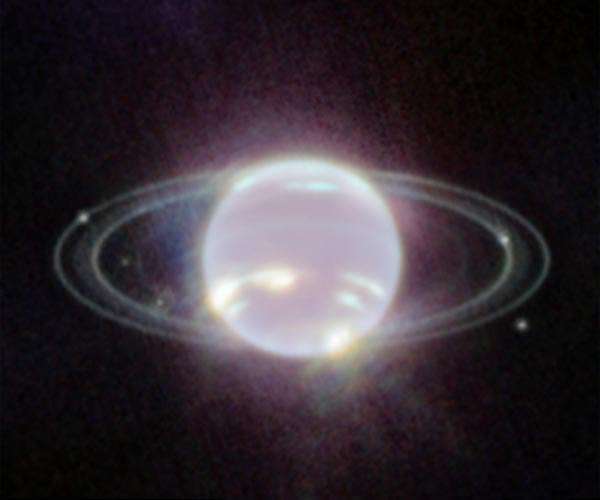
A recent file image of Nepture and it's ring by the Webb Telescope.
A ring of icy rocks orbiting our sun just beyond Neptune may give us a glimpse of how Neptune - and other objects in the outskirts of our solar system - were formed.
Mors-Somnus, a binary duo comprised of a pair of icy asteroids bound by gravity, was recently concluded to have originated within the Kuiper Belt, meaning it can serve as a basis to study and enrich our understanding of the dynamical history of Neptune and celestial bodies known as trans-Neptunian objects (TNOs).
The promising study, published recently in the journal Astronomy and Astrophysics, marks the first time this has been achieved and serves as a significant landmark for the UCF-led Discovering the Surface Compositions of Trans-Neptunian Objects program - or DiSCo-TNOs - which is part of the first cycle of the James Webb Space Telescope's (JWST) many programs focused on analyzing our solar system.
Ana Carolina de Souza Feliciano and Noemi Pinilla-Alonso, a postdoctoral fellow and professor in planetary science at UCF's Florida Space Institute respectively, are co-authors of the study and part of the DiSCo team that studies unique spectral properties of small celestial bodies beyond Neptune within the Kuiper Belt.
What is unique to this work is that it is possible to study the surface composition of two components of the binary pair of small-sized TNOs, which had never been done before and can have implications for how we understand the whole region beyond Neptune.
De Souza Feliciano led this particular study as part of Pinilla-Alonso's greater DiSCo-TNOs program. The team used the JWST's wide spectral capabilities to analyze the elemental composition of a half-dozen suspected closely related TNO surfaces to confirm that Mors-Somnus has much in common with its neighboring TNOs. These largely undisturbed TNOs are designated as "cold classical" and may serve as points of reference where Neptune didn't disturb them during its migration.
Together, the binary objects and other nearby TNOs in the same dynamical group can act as an indicator to potentially track Neptune's migration before it settled into its final orbit, the researchers say.
Binaries separated by distance, as Mors-Somnus is, rarely survive outside of areas bound by gravity and sheltered by other flecks of ice and rock such as the Kuiper Belt. To survive implantation in such areas, they require a slow transportation process toward their destination.
Due to the similar spectroscopic behavior of Mors and Somnus and their similarities with the cold-classical group, the researchers found compositional evidence for the formation of this binary pair beyond 30 astronomical units (nearly 2.7 billion miles away), as is also hypothesized in the previously published literature for the region where the cold-classic TNOs are also formed.
The steady stream of discoveries such as this were somewhat expected, as the first data from the DiSCo-TNOs studies on nearly 60 TNOs began to trickle in as early late 2022.
"As we started to analyze the Mors and Somnus spectra, more data were arriving, and the connection between the dynamic groups and compositional behavior was natural," de Souza Feliciano says.
More specifically, studying the composition of small celestial bodies such as Mors-Somnus gives us precious information about where we came from, Pinilla-Alonso says.
"We are studying how the actual chemistry and physics of the TNOs reflect the distribution of molecules based on carbon, oxygen, nitrogen and hydrogen in the cloud that gave birth to the planets, their moons, and the small bodies," she says. "These molecules were also the origin of life and water on Earth."
However, she says there still remains great opportunity to advance our knowledge of the history of the Trans-Neptunian region with the unprecedented spectral powers of JWST.
"For the first time, we can not only resolve images of systems with multiple components like the Hubble Space Telescope, but we can also study their composition with a level of detail that only Webb can provide," Pinilla-Alonso says. "We can now investigate the formation process of these binaries like never before."
Although Pinilla-Alonso conceived the DiSCo-TNOs program, she trusts her colleagues such as de Souza Feliciano to decipher the findings and generate valuable research.
"I am proud to have played a role in providing the necessary data and support to (Ana) Carol(olina), a brilliant UCF postdoctoral researcher who has been the true leader of this work," Pinilla-Alonso says. "With the Webb telescope set to last for decades, this is an amazing opportunity for the next generation of researchers to step up and lead their science projects."
Being a trailblazer for such incredible discoveries truly is exciting, de Souza Feliciano adds.
"Before JWST, there was no instrument able to obtain information from these objects in that wavelength range," she says. "I feel happy to be able to participate in the era inaugurated by the JWST."
Quelle: SD
